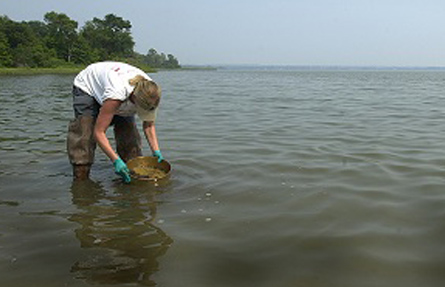Chalk Point
Oil Spill | Patuxent River, Maryland | April 2000
What Happened?
On April 7, 2000, a 12-inch oil pipeline ruptured underground at the Pepco Chalk Point electric generating facility in Aquasco, Maryland. Approximately 140,000 gallons of oil spilled into Swanson Creek, a small tributary of the Patuxent River. The oil moved over containment booms, ultimately affecting approximately 40 linear miles of environmentally sensitive downstream creeks and shorelines along the Patuxent River.
What Were the Impacts?
The spill oiled over 80 acres of wetlands and shoreline, killing more than 1,000 birds and animals, including waterfowl, diamondback turtles, and muskrats.The oil also harmed fish and shellfish, and resulted in the loss of an estimated 125,000 river trips by fishermen and recreational boaters.
What’s Happening Now?
NOAA and co-TrusteesGovernment officials acting on behalf of the public when there is injury to, destruction of, loss of, or threat to natural resources. conducted a natural resource damage assessment (NRDA)Investigation performed by trustees to identify injuries to natural resources caused by oil spills, hazardous substance releases, and grounding incidents in National Marine Sanctuaries, and plan restoration activities. The goal of NRDA is to restore natural resources and compensate the public for lost recreational use., reaching a $2.7 million settlement in December 2002. From 2002 to 2018, the Trustees have completed the following restoration projects to compensate the public for injuries to natural resources and related recreational losses:
- Created six acres of intertidal wetland adjacent to Washington Creek, a tributary of the Patuxent River.
- Enhanced and protected shoreline by creating one acre of new beach and protecting 1800 feet of shoreline.
- Restored and protected nesting habitat in the midwestern U.S. for ruddy ducks (which winter in the Chesapeake Bay region and were affected by the spill).
- Created five acres of oyster reef sanctuary in the Patuxent River and seeded it with native oysters.
- Constructed several recreational projects, including two new paddle-in campsites and improvements to boat launches and fishing piers.
The 2002 Restoration Plan called for two additional recreational access projects in the vicinity of the oil spill but these originally planned projects proved infeasible due to input from local communities and government partners. The trustees have identified an alternative project to compensate for lost recreational use. The alternative project was provided to the public for comment in the October 2018 Draft Amendment to the 2002 Restoration Plan. It proposed to construct a boardwalk and pier at Jefferson Patterson Park.
The Final Amendment to the 2002 Restoration Plan was approved in Janurary 2019. The Jefferson Patterson Park Pier and Boardwalk Project provided a new publicly accessible pier to replace an existing pier destroyed by Hurricane Isabel in 2003 as well as a boardwalk. The trustees allocated $350,000 to implement the proposed project.
“The restoration process is nearly complete at this time, and the area affected by the spill has shown itself to be very resilient. Once we have implemented additional projects to enhance recreational access, the public will be fully compensated for losses from the spill.”-- Rich Takacs, NOAA Restoration Biologist
Contacts
Rich TakacsNOAA Restoration CenterAnnapolis, MD(410) 573-4543Rich.Takacs@noaa.govDan MurphyU.S. Fish and Wildlife ServiceAnnapolis, MD(410) 573-4521Dan. Murphy@fws.govJonathan McKnightMaryland Department of Natural ResourcesAnnapolis, MD(410) 260-8539Jonathan.McKnight@maryland.gov









